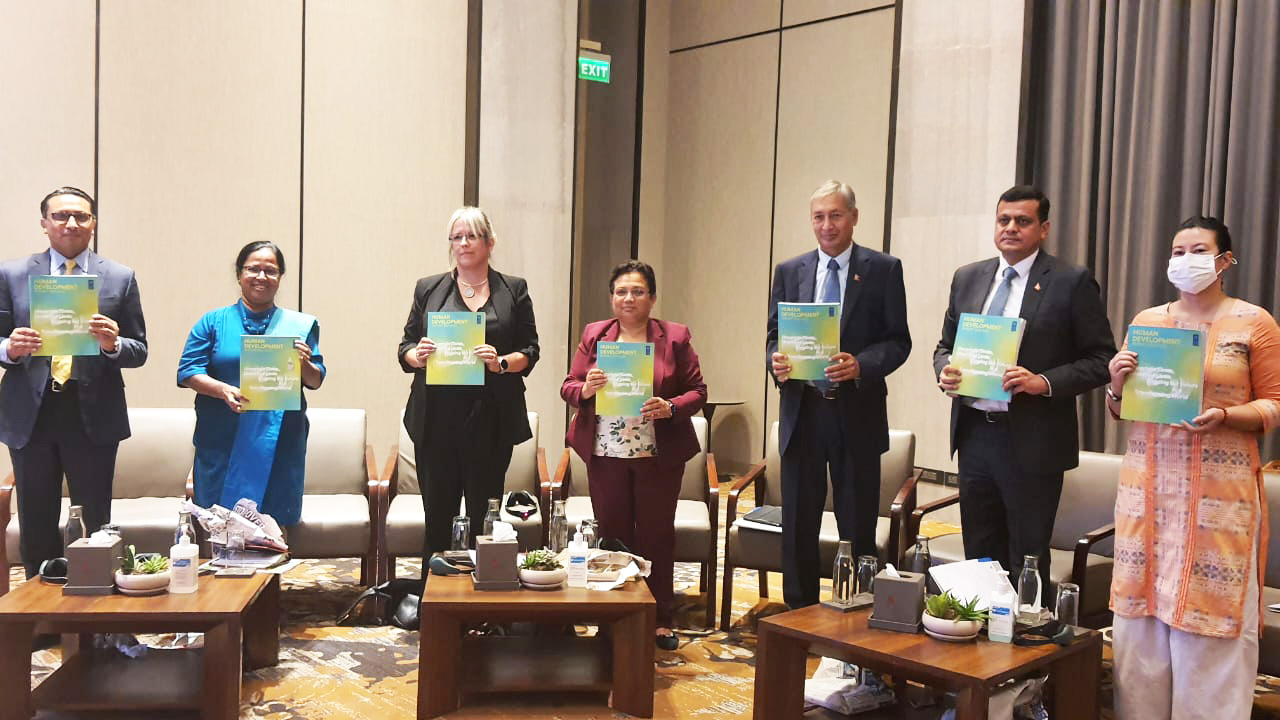Nepal moves up one place in human development, ranks 143rd
September 12, 2022

HDR Launch 2021/2022 by (from left: Dr. Swarnim Waglé, Ayshanie Labe, Pippa Bird, Hon’ble Ms. Pampha Bhusal, Dr. Yuba Raj Khatiwada, Mr. Sushil Bhatta and Ms. Yubika Bhandari)
Kathmandu, Nepal
While Nepal improved its ranking from 144th to 143th position, the Human Development Index (HDI) value has marginally declined from 0.604 to 0.602 due to continued turbulence caused by the COVID-19 pandemic.
From the lens of gender, Nepal stands at 113th position in global Gender Inequality Index.
Released after a two-year gap, the 2022 Report puts the country in the Medium human development category.
The HDI is a summary measure for assessing long- term progress in three basic dimensions of human development: a long and healthy life, access to knowledge and a decent standard of living.
Between 1990 and 2021, Nepal's HDI value changed from 0.399 to 0.602, a change of 50.9 percent. Between 1990 and 2021, Nepal's life expectancy at birth changed by 13.6 years, mean years of schooling changed by 2.8 years and expected years of schooling changed by 5.4 years. Nepal's GNI per capita changed by about 146.0 percent between 1990 and 2021.
The analysis shows Nepal’s continues to incur substantive loss in human development due to persisting inequalities. Nepal continued to a loss of over 25% in human development due to inequalities across gender, caste, geographic regions and other categories. As the inequality in a country increases, the loss in human development also increases. The 2021 female HDI value for Nepal is 0.584 in contrast with 0.621 for males, resulting in a GDI value of 0.942, placing it into Group 3[1] which comprises countries with medium equality in HDI achievements between women and men.
Records show during 2019 and 2020, Nepal’s performance was comparatively low in the areas, including maternal mortality, shares of parliamentary seats held by women, and women’s participation in the labour force.
The Gender Inequality Index measures gender inequalities (the loss in human development due to inequality between female and male achievements) in three key dimensions – reproductive health, empowerment, and labour market. Reproductive health is measured by maternal mortality ratio and adolescent birth rates; empowerment is measured by the shares of parliamentary seats held and population with at least some secondary education by each gender; and labour market participation is measured by the labour force participation rates for women and men.
“The current rating shows that Nepal is progressing in the Human Development Index and ranking, but we must work harder to progress further. We must invest in the areas of education, health, renewable energy, agriculture to build a resilient Nepal. The government has been investing in increasing people’s access to health services in the villages. The government is making special efforts to maximize the use of locally produced electricity, including by providing free electricity to the poor and exporting excess energy to other countries. This is expected to help us come out of the cycle of poverty,” said Hon. Minister for Energy, Water Resources and Irrigation Ms. Pampha Bhusal.
“The new Human Development Report indicates Nepal has largely maintained stable position over the past two years despite numerous shocks, including COVID-19 pandemic and natural disasters. This is because of the long investments over the years. Going forward, we need everyone’s wisdom, experience and more importantly the positive attitude to cope with crisis and making more choices available to the people,” said Ayshanie Medagangoda-Labe, UNDP’s Resident Representative in Nepal.
The report was presented by Dr. Swarnim Wagle, Chief Economic Advisor, UNDP Asia and the Pacific. Other speakers at the launch were Dr. Yuba Raj Khatiwada, Former Finance Minister of Nepal, Ms. Pippa Bird, Development Director at British Embassy in Nepal, Mr. Sushil Bhatta, CEO, Investment Board Nepal, Ms. Yubika Bhandari, Secretary, Nepal Association of Tour and Travel Agents, Ms. Moushumi Shrestha, Entrepreneur, and Mr. Prakash Rimal, Editor-in-Chief, NepalMinute.com.
South Asian Countries in HDI Ranking
Afghanistan 180
Bangladesh 129
Bhutan 127
India 132
Maldives 90
Nepal 143
Pakistan 161
Sri Lanka 73
The full video of the live cast of the launch event is available online: https://www.facebook.com/UNDPNepal/videos/643084150521524
[1] Countries are divided into five groups by absolute deviation from gender parity in HDI values. Group 1 comprises countries with high equality in HDI achievements between women and men (absolute deviation of less than 2.5 percent), group 2 comprises countries with medium to high equality in HDI achievements between women and men (absolute deviation of 2.5–5 percent), group 3 comprises countries with medium equality in HDI achievements between women and men (absolute deviation of 5–7.5 percent), group 4 comprises countries with medium to low equality in HDI achievements between women and men (absolute deviation of 7.5–10 percent) and group 5 comprises countries with low equality in HDI achievements between women and men (absolute deviation from gender parity of more than 10 percent).

 Locations
Locations